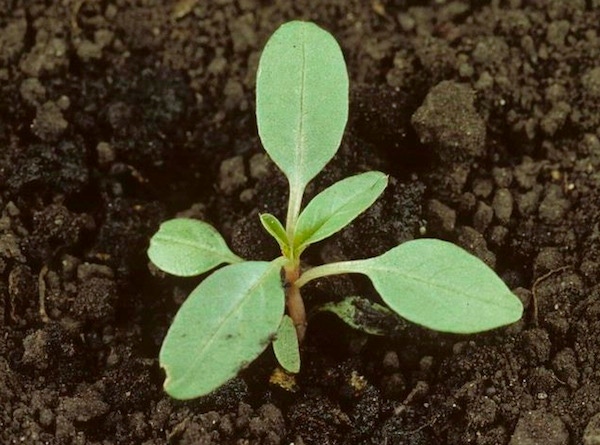July 26, 2016

Researchers have spent a lot of time educating and warning about Palmer amaranth. However, that didn’t stop waterhemp from becoming an even bigger problem
Waterhemp is only a little less fun to deal with than Palmer amaranth, and has a tendency to fairly rapidly develop resistance to any new sites of action used repeatedly against it in POST treatments. Submitted questions and photos to confirm identification of this weed increased substantially this summer over previous years.
Waterhemp infestations can be found around Ohio, with a concentration in west central Ohio. We assume all waterhemp populations are resistant to site two herbicides (ALS), but in our screening so far, not all populations are resistant to glyphosate. Populations in western Ohio tend to be glyphosate-resistant at this point, but populations in other parts of Ohio not necessarily so. Some populations that are glyphosate-resistant appear to have developed at least a low level of resistance to site 14 (PPO) herbicides as well.
In areas of the corn belt further west where waterhemp has been the major glyphosate-resistant weed problem for some time, the evolution of multiple resistance is common. Recent surveys by the University of Illinois determined that approximately 60 percent of Illinois waterhemp populations were resistant to glyphosate and also to site 2 and 14 herbicides.
Due to the tendency for waterhemp to evolve resistance to new sites of action used against it, the U of I recommends a strategy of not using a new site of action (usually PPO) until resistance to glyphosate has been confirmed.
So in a field situation where a grower is unsure about resistance, they suggest applying glyphosate to small waterhemp plants, and then monitoring to determine if the population is responding.
If there is no response, the next step is immediate application with a PPO inhibitor. The drawback here of course is that glyphosate-resistant waterhemp will continue to grow during this brief period of evaluation following glyphosate application, possibly reducing the effectiveness of the PPO herbicide.
Waterhemp requires a combination of residual and POST herbicides, with the goal of applying POST herbicides to plants not more than 6 inches tall.
In a number of Ohio fields with waterhemp that we know of, growers were either unaware they had waterhemp and inadvertently let it get far bigger than this, or were apparently still adhering to the “I’ll spray glyphosate whenever I get around to it – what, me worry” approach.
Waterhemp produces a lot of seed and one or two years of this approach will guarantee the presence of waterhemp for years to come.
It’s largely too late to provide much helpful guidance for this summer’s waterhemp control programs. What’s essential to accomplish still this year though, for future planning, is to figure out whether a waterhemp population is resistant to glyphosate and/or site 14 herbicides.
Fortunately, there is a painless way to do this, through a service offered by the University of Illinois Plant Clinic.
In a nutshell, you collect five new leaves that have developed following an herbicide application, and send them to U of I via rapid delivery along with one sample submission form per sample. Cost is $50 per sample, which includes screening for both glyphosate and site 14 herbicides.
We highly recommend making this investment where resistance characteristics of a waterhemp population are unknown. This information will inform future decisions on herbicides for control of waterhemp, ensuring that appropriate herbicides are used and that the population does not develop resistance to site 14 herbicides as rapidly.
The LibertyLink soybean system is, of course, another option for management of waterhemp, as well as Xtend and Enlist soybean systems whenever they become available. It should be noted that: 1) use of glufosinate, dicamba, or 2,4-D to help manage this weed does not change the approach, and these herbicides must be applied to small plants to control waterhemp; and 2) the assumption is that inappropriate and continued use of these herbicides would lead to the development of resistance to them. And in fact there are already some populations of waterhemp farther west with resistance to 2,4-D.
You May Also Like




